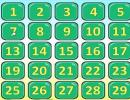Game program Masha and the Bear. MASHA. Nutrition in educational institutions Energy value by meals
Our company has developed and successfully implemented the MASHA service, designed to automate work processes in educational institutions. This product is aimed at effectively solving real problems that arise when organizing rational nutrition in an institution. The implementation of the system will significantly reduce manual labor associated with daily calculations. In addition, you will be able to fully control all processes related to the organization of rational nutrition.
Currently, this system is successfully used by more than 800 institutions throughout the country.
Main features of the system
1. Automatic generation and printing of menu requirements based on a two-week perspective menu in accordance with Guideline No. 11 – 14 – 1 – 2000
1.1 The menu layout lists the dishes of the daily diet, indicating the theoretical yield, separately for each age category.
1.2 The calculation of each dish is carried out automatically, according to the “Collection of recipes for dishes for children of early and preschool age”
1.3 The software contains an electronic version of all recipes in this collection, and also provides search and selection of the required recipe.
1.4 Calculation of the consumption of raw materials for each recipe is determined automatically, according to the tables for calculating the consumption of raw materials, the yield of semi-finished products and finished products in accordance with the instructions of the “Collection of recipes for dishes for infants and preschool children”.
1.5 Possibility of writing off perishable products within the pre-order with subsequent automatic calculation of the yield of the dish in accordance with Guideline No. 11 - 14 - 1 - 2000.
1.6 In the event of non-delivery of certain food products, it is possible to automatically replace them, taking into account the “Norms for the interchangeability of products when preparing dishes.”
1.7 Automatic generation of information for parents about the daily diet of pupils with the recommended set of products for home dinner in accordance with Sanitary Regulations dated January 25, 2013. No. 8.
2. Nutrition analysis
Monitoring the implementation of natural nutrition standards, in accordance with the Resolution of the Council of Ministers of the Republic of Belarus dated April 27, 2013. No. 317, with keeping records of food consumption according to the savings sheet for one child.
2.1. Automatic generation of the report “Characteristics of nutrition for a set of products”, in accordance with the requirements of San PiN dated January 25, 2013. No. 8.
2.2. Automatic generation of the report “Chemical composition and calorie content of food” according to the form, according to San PiN dated January 25, 2013. No. 8 and Resolution of the Ministry of Health of the Republic of Belarus dated November 20, 2012. No. 180.
2.3. Daily control of cash expenses.
2.4. Generating a report that takes into account the distribution of calorie content of the daily diet for individual meals (San PiN dated January 25, 2013 No. 8).
3. Control of cash expenses
The system automatically generates and allows you to print a calculation sheet. It displays the financial status for the day, for the month and for the current year as a whole.
When creating a menu, it is possible to track the cost of portions of each meal in real time.
4. Accounting for invoices and product prices
4.1. Possibility of automatic calculation of the quantity of products for subsequent generation of requests for food products.
4.2. Automatic maintenance of a ledger for the receipt and consumption of products.
4.3. Automatic display of expiration dates of all food products entering the catering unit. (San PiN dated January 25, 2013 No. 8), (Guide No. 11 – 14 – 1 – 2000)
4.4. Possibility of automatic calculation of food balances in the pantry.
4.5. Formation of “Requirements for the issuance of products” to the catering unit for all categories of food users.
Simultaneously work with several categories of nutritionists, including SPC, CCRO and other institutions with similar principles of catering.
6. Recipes
The basic version already contains cards for main dishes, according to the “Collection of recipes for children of early and preschool age 2003”, “Collection of technological cards of dishes and products for children of early and preschool age. (2016 in two volumes)”, “Collection of technological maps of dishes and products for feeding students of institutions providing general secondary education”. You can create your own recipes and edit existing ones.
7. Formation and management of the list of products
Dividing products into groups. Adding different categories of one product. Accounting for waste and residues.
8. Additional reports for centralized control.
The district technologist or auditor can monitor the implementation of natural standards or compliance with storage periods in all subordinate institutions.
Support for an unlimited number of users. Work from any computer connected to the Internet. Availability 24 hours a day.
No, no, of course, we are not talking about teaching kindergarteners how to program or work in some kind of automation package. We want to tell you about the MASHA system, which helps in automating the work of preschool institutions.
This system is Belarusian, and it was developed by the Belhard companies. At first glance, it seems that a system that automates the work of a preschool institution (in Russian, a kindergarten) is either nonsense or an oxymoron. You can't replace nannies and teachers with robots, you can't automate children's walks and sculpting Easter cakes in the sandbox. All this, of course, is true, but it is perfectly possible to automate such aspects as food accounting, menu creation, and generation of reports on food consumption for children. MASHA copes well with these tasks, freeing up time for kindergarten workers for the most important thing - raising children.
More information about MASHA can be found on the product website. But, I think, since “Computer News” has begun to talk about this program, it would not be superfluous to mention some data from the official website.
MASHA includes several modules. One is responsible for keeping records of products and is called, accordingly, “Pantry”. When products are delivered, they can be added to a list with invoices and expiration dates, so that they can later be taken into account when creating a menu. Another module is already responsible for it - “Nutrition”. It already contains recipes for the main dishes that are fed to children in Belarusian kindergartens today, and based on information about the number of children and the yield of the dish, the module can independently calculate the daily menu. But perhaps the most important module is “Reports and Statistics”. Because it has long been known that “without a piece of paper you are a bug.” And for every gram of product you need to report, check that all natural standards for products, the chemical balance of the diet, as well as monetary standards are observed.
Despite the fact that the system has a modular structure, it is somehow hard to believe that any kindergarten in its right mind would refuse at least one of these modules. However, it is possible that kindergartens, like many government organizations, are so conservative that they are hostile to any automation. Although, judging by the screenshots on the product website, MASHA modules are distinguished by a user-friendly interface, but try teaching even such a convenient product to a dietician who, due to her considerable experience, is accustomed to paper magazines!
- How much does MASHA and its individual modules cost?
Currently 250,000 Belarusian rubles per month. This amount includes all modules related to nutrition, technical support and consultation. The modules are not yet sold separately.
- What other modules are planned to be added?
The plans include the development of modules to facilitate the work of the personnel service of preschool institutions, a module for inventory, as well as developments depending on the needs of the individual customer.
Vadim STANKEVICH
"MASHA"
our help
Automated menu creation system.
Using a computer program
"MASHA "
Every day in the preschool institution a menu is drawn up - a requirement for the daily (daily) diet, which is approved by the head.
Within the limits of their competence, the manager, storekeeper, chef and medical worker participate in drawing up the menu requirements.
In the age of modern technology, no one is probably surprised by the emergence of new computer programs that make our lives easier. And a person with a pencil in his hands, diligently counting calories, kilograms and amounts on a calculator, brings a smile.
The program allowed us to automate the daily process of creating menus. Previously, this took a lot of time - half a day had to be calculated, for example, how many kilograms of meat the storekeeper received, how many servings could be prepared from this product, and not to forget about the number of children whom parents brought to the garden on a particular day. And this is just the tip of the iceberg. Today, thanks to the program with the good name MASHA, the menu is compiled quickly. At the same time, you no longer need to keep a huge amount of information in your head. It is enough to enter the necessary data, and the program itself will calculate how much a child’s food costs per day, will not forget to take into account all natural norms, and will also recalculate if necessary.
If previously you could spend a full day working on calculating the food menu and keeping logs, now it can be done in 15 minutes.In fact, the information is entered into the system once, and further calculations are automated. This significantly increases the accuracy of calculations.
Key Features
"MASHA" programs -
provides modularity of the entire application:
Module "Dish recipes"
WITH will receive cards according to the "Collection of recipes for children of early and preschool age 2003". Allows you to add and edit your own recipes. It also allows you to take into account the percentage of waste, portioning losses, and conversion factors.
Module "Creating a 10-day menu"
Designed to create an approximate 2-week menu, which is a template for creating a main menu.
Formation of daily menu requirements based on guideline No. 11-14-1-2000 “Organization of rational nutrition for children in preschool institutions.” It is also possible to create a separate me for children on a diet.
In addition to directly compiling and calculating menus, the section allows you to upload information in the form of PDF files
- product bookmark control (replaces the bookmark control log)
- menu requirement for submission to the education department
- menu and special menu for parents, which is given to each group
Module "Calculation of one day"
Displays the result form to confirm the calculation of one day. It also allows you to add or remove products based on the arrival or absence of children. Additionally, the system displays information about cash expenses for the day in question, as well as the balance of funds for the current month. After checking, the calculation can be completed (close the day). After this, no changes to the menu or calculations are allowed.
Allows you to generate and print a calculation sheet for a given day, which reflects the cost of products for the day, as well as comparison of these costs with the planned consumption based on the current price of the day.
Module "Meeting natural standards"
Allows you to monitor the fulfillment of natural standards for a month, with the calculation of intermediate sections for 10 and 20 days. It also allows you to print a cumulative table in 10 days
Another control parameter is the implementation of the 10-day menu. The system automatically generates and allows you to print a table of compliance with natural standards and standards for chemical composition for 10 and 20 days.
Module "Pantry"
This module helps you keep track of food products. Products are divided into groups for subsequent monitoring of compliance with natural standards. Each product has an approved technology code. In addition, information about invoice numbers and the cost of imported products is entered into the system.
Module "Products"
The system already contains a completed directory of products necessary to create a menu according to the recipe collection. The product directory allows you to edit various product properties, as well as add new products. For each product, you can indicate its chemical and mineral composition. In addition, you can specify a type (category) with your own individual code. For example, the product “Juice” can be “apple”, “orange”, etc.
Module "Reports and Statistics"
The module automatically generates and prints reports on the receipt and consumption of each product, as well as the cost of products for each day and for the selected month as a whole.
Module "Children"
This module helps to mark children present and absent. An attendance sheet is automatically generated.
The menu in the kindergarten is compiled taking into account the requirements of SanPin and the seasonal availability of products. The menu in kindergarten for the day and for the week is drawn up by the head of the preschool educational institution together with the head of the catering department. Children should receive a balanced and varied diet.
In preschool educational institutions (hereinafter referred to as preschool educational institutions), children are offered a nutritious and varied diet. An approximate menu in a kindergarten takes into account the age of the pupils, the time of year and the state of health of the children. The menu in the preschool educational institution has some features:
- dishes are repeated no more often than once every 20 days;
- the daily diet for children under three years of age is 1540 kcal, for children over three years old - 1900;
- the diet includes a nutritious breakfast, fruit juices and fruits, second breakfast, a hearty lunch and an afternoon snack;
- For breakfast, pupils should receive a quarter of the daily ration, about 15% is taken up by the second breakfast and afternoon snack, and children receive 45% of the ration at lunch.
Menu in kindergarten for the day
The Institute of Nutrition of the Russian Academy of Medical Sciences has developed standards for children's nutrition in preschool educational institutions. The diet is compiled for each age group of children. The quality of the products is monitored by the SES and the head of the kindergarten and catering department. In Russian kindergartens, the kindergarten menu form for each day is filled out by a nutrition specialist who is responsible for the children’s diet.
Before serving food, the nurse must fortify the third and first courses with vitamin C; for children under one year old, 30 mg of the vitamin is prescribed, 1-6 years old - 40 mg, and children over 6 years old - 50 years old.
Every day, children 2-5 years old should receive the following foods (in grams):
- Porridge or vegetables - 180-200,
- Coffee, tea, cocoa - 150,
- Soups, broths - 150-200,
- Meat or fish dishes - 60-70,
- Compotes, jelly - 150,
- Combined side dishes - 100-150,
- Fruits, juices - 50-100,
- Vegetable or fruit salads - 40-50,
- Rye bread (all day) - 50,
- Wheat bread (for the whole day) - 110.
KEEP THIS FOR YOURSELF SO YOU DON'T LOSE:
The magazines “Directory of the Head of a Preschool Institution” and “Directory of the Senior Educator of a Preschool Institution” published important materials for heads of preschool educational institutions:
Every day, children in the kindergarten eat four times: they have lunch, an afternoon snack and two breakfasts. In some cases, three meals a day are acceptable if the diet is prepared by a full-time nutritionist and does not provide for deviations from the norm in calorie content. The children's table includes fish and meat dishes, eggs, cereals, dairy products, fruits and vegetables, pastries, juices and hot drinks. Pupils can always ask for additional non-portioned dishes if the portion is not large enough for them.
The diet can also be developed for a child with food allergies. To do this, parents should provide the results of allergen tests to the preschool educational institution, and then notify the teacher or staff nutritionist so that the kindergarten staff know which foods the child should not eat. When compiling a diet for pupils, the nutritionist will try to eliminate allergens.
To prepare your child for kindergarten meals, parents should:
- Ask the teacher for an approximate menu in kindergarten with recipes in order to gradually accustom your child to such food.
- Refuse foods that are radically different in taste and composition from the food at the preschool educational institution.
- Do not give your child exotic foods, smoked, salty, fatty and spicy foods that are not on the approximate menu. It is important for mom to know that in kindergarten, dishes are prepared with a minimum of fat; butter and vegetable oil are often used for cooking.
- It is worth diversifying your home menu with simple dishes, completely eliminating carbonated drinks, mayonnaise, ketchup, crackers and chips.
- It is important to follow the principle of 5 meals a day at home, so it will be easier for the child to get used to the meal schedule in the preschool educational institution.
- You should not give your child double portions of food, thinking that he is malnourished in kindergarten. Portions must be appropriate for age, otherwise obesity or gastrointestinal problems can be caused.
- If the family does not adhere to the diet, you should gradually wean the child from snacking between meals.
Menu in kindergarten for a week
Preschool meals in kindergartens, the menu of which is prepared by a medical worker, are subject to mandatory approval by Rospotrebnadzor employees. The menu specifies not only the size, but also the consistency of the portions (for children in nursery groups, food is given pureed). It is important that the dishes are combined with each other. So, if for lunch children receive borscht, vegetable soup or pickle, for the second they should have vegetables, a vegetable salad or a side dish of pasta or cereals. If cereal soup is served as a main dish, vegetable stews and salads are recommended as a side dish. To increase appetite, children receive fresh or salted vegetables before lunch.
Menu in kindergarten for a week, nursery group
The nursery group of the kindergarten is children 1-2 and 2-3 years old. Babies need a complete, balanced diet with calories ranging from 1200 to 1500 kcal per day. The menu for a nursery group in a kindergarten is compiled for 10 days by a medical worker, certified by an employee of Rospotrebnadzor and confirmed by the head of the preschool educational institution. The diet depends on the time of year and can be summer-autumn and winter-spring.
According to SanPin standards:
- who are in the garden for more than 8 hours should be four to five times a day.
- There should be an intermediate meal between breakfast and lunch, which includes fresh fruit and a drink.
- If fresh vegetables are not available, they are replaced with juices or frozen fruits and vegetables.
- The afternoon snack can be light and compact if dinner is not provided.
A sample menu in a nursery school for a week is compiled taking into account the availability of seasonal vegetables and fruits. Several times a week there should be eggs, cottage cheese and fish on the children's table; butter, meat, cereals and fresh vegetables are included in the daily menu. Mushrooms, vinegar, horseradish, flasked milk, semi-finished products, smoked meats, waterfowl meat, mayonnaise, and canned food are strictly prohibited for children.
Weekly menu for kindergarten students






